About 180 kilometers into the mission, the gravity of the situation pulled me down like a lead weight toward the thick ice and the inky black bottom below. This was supposed to be a 100-kilometer recon trip across Greenland’s glorious frozen landscape. However, the original plan had long been discarded. Now we were literally stuck on a sea of ice in the middle of nowhere, and I was way outside my comfort zone.
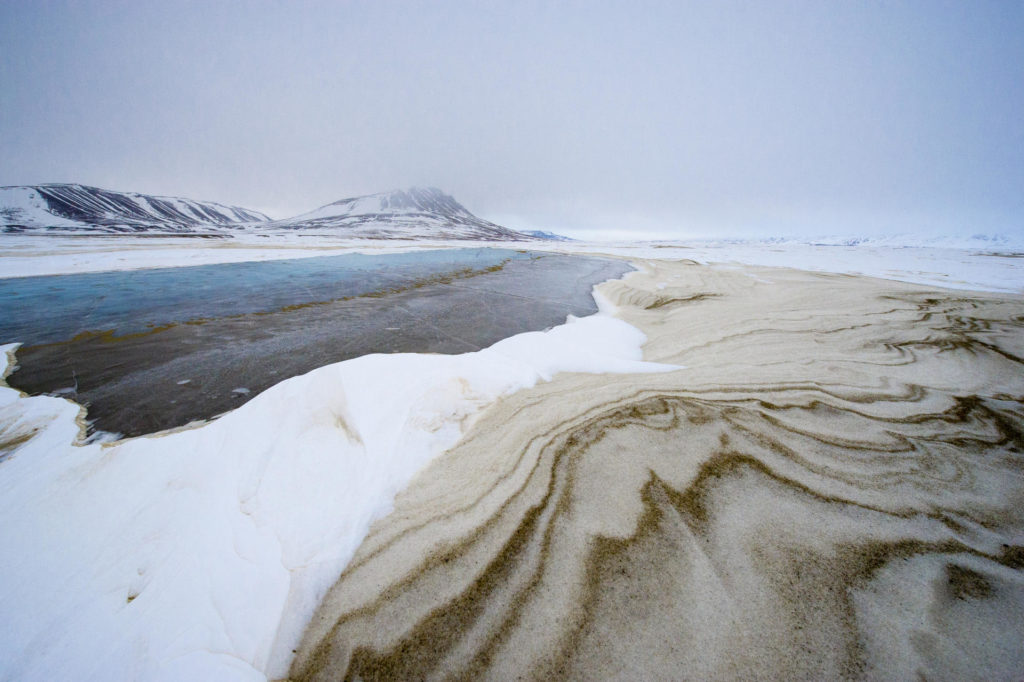
“Is that it?” This was the thought that went through my head as I peered out the window of our Twin Otter plane as it descended toward Greenland. Jammed between baggage and boxes of supplies for our two-month expedition, I was peering down at the tiny collection of sheds and the strip of ice-covered dirt that is Greenland’s most northern airport. This outpost is the only way in or out of the northeast region of the largest island on the planet.
I had been invited on this Australian Geographic-funded expedition as an “experienced” guide and cameraman and enthusiastically committed to the two-month filming assignment in one of the most remote places on earth. But as the plane plummeted toward the icy collection of rusty sheds, nothing could have prepared me for what lay ahead.
Six of us arrived to set up operations. A base camp manager, snow mobile mechanic, lead guide and three other guides, with two of us doubling as the film crew.
Our mission was to capture the expedition, the people and the daily challenges of life in the Arctic. It would be the most challenging undertaking of my life and, as the plane skidded to a sliding halt, it was about to begin.
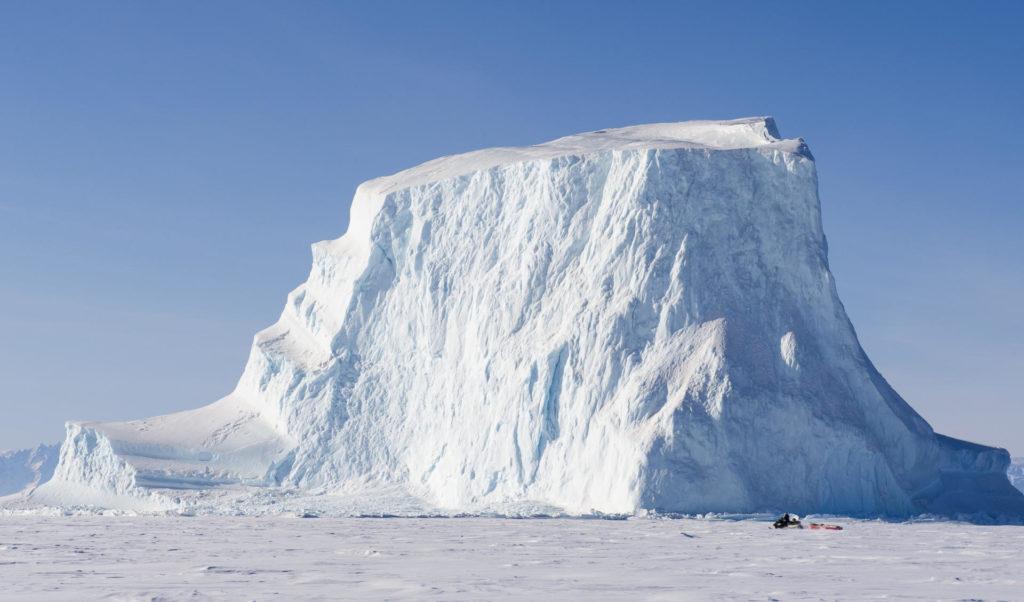
The Mission
After a month of settling in and exploring the region, it was time for the longest reconnaissance mission of the expedition. Four of us left our tiny base camp near Nerlerit Inaat Airport early in the morning with fuel and provisions; each riding a snowmobile pulling a heavily laden trailer weighing nearly 250 kg.
We all had experienced harsh winters.
Phil Poole, our lead guide, had several years in Greenland under his belt. Gunilla Lindh grew up amid unforgiving Swedish winters, Darren Harris was an experienced skier from the French Alps and, although I grew up in Australia, I had spent the last seven winters in Hokkaido working as a photographer and guiding film crews in the north island’s legendary backcountry.
Our plan was to travel the 100 kilometers to Sydkap Hut at the top of Scorseby Sund fjord, leaving a fuel depot stocked for future trips. We would reach the hut by early afternoon and spend the night. The next day, we would venture farther into Milne Land and see if we could find routes into some unexplored fjords, returning home in time for dinner that night.
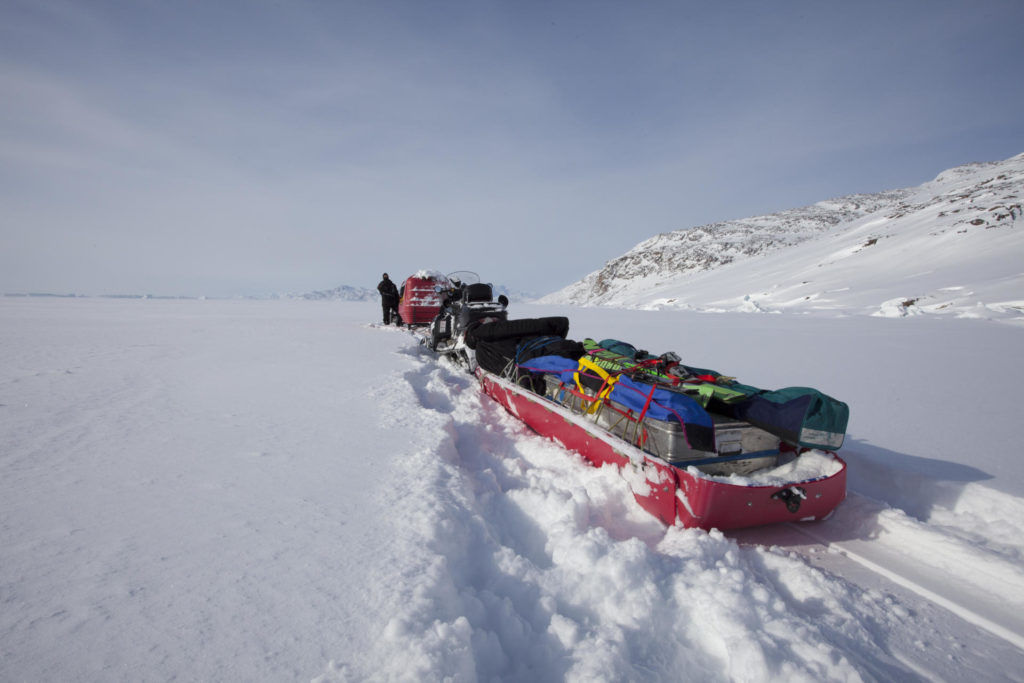
Poor weather, raging Arctic winds and variable snow and ice conditions forced us to traverse the length of Scorseby Sund fjord instead of cutting through the mountains. This turned out to be a disastrous mistake. We found ourselves navigating icebergs frozen into the sea ice, blanketed by fresh waist-deep snow. The route had doubled the distance and had taken its toll on us and the snowmobiles.
It was now 9 p.m. and, although the sun was still teetering above the mountains, the temperature was plummeting below -30C. It had been a balmy -20C for most of the 11 hours we had just spent on snowmobiles.
Totally exhausted, we now found ourselves staring at frozen sea ice, a broken down snowmobile and staring at polar bear tracks zig-zagging across our path. It was remote, incredibly cold and, while no one openly admitted it, we were all scared.
Scoresby Sund
We had been approaching the top of Scoresby Sund, the largest and longest fjord system in the world. Scoresby punctuates the southern tip of the Northeast Greenland National Park, the largest National Park on the planet – bigger than all but 30 countries in the world.
This fjord system covers 38,000 square kilometers and plunges to 1,450 meters deep at its heart. It is high in the Arctic Circle on Greenland’s northeast coast and is the birthplace of some of the largest icebergs on earth. It is true wilderness, a land ruled by polar bears.
When we rounded the bottom of Jameson Land earlier that morning, we were buzzing with anticipation, eager for a glimpse of these gigantic ‘bergs. We had pushed our snowmobiles and our bodies to the limit. We were exhausted. Suddenly, there they were; icebergs the size of cathedrals.
From the moment you first spot one of these monsters, it could be several hours before you were able to see the full ’berg. The sheer scale is difficult to describe, except to say I have never felt so insignificant.
Hundreds of these magnificent ice monsters were scattered across the fjord. Huge frozen peaks were visible in the distance with nothing else but flat white surrounding them. Only the ghostly shadows of the ’bergs and the footprints of bears patrolling the ice broke the spell of this view.
Not long into the trip, we had hit deep snow and were covered from goggles to gloves. The snowmobiles were having trouble getting through, so we sent one machine out in front to break trail while the rear snowmobile towed two trailers. Hours of ploughing through the powder eventually killed the lead sled, and we were now in more than just deep snow; we were in deep shit.
The Red Hut
We managed to tow the broken snowmobile off the ice and onto the edge of the fjord. We dumped some fuel barrels, loaded our supplies onto three snowmobiles and set off again for the hut. The final 20 kilometers were slow going. Temperatures continued to drop, and we were losing visibility. The cloud cover was causing a misty, low-contrast whiteout on the fjord. It took us three freezing, gruelling hours.
The sight of the tiny red hut, tucked into the edge of the fjord, was one of the most wonderful moments of my life. This abandoned hunting shelter had no heating or comforts, but it was out of the wind and much safer from bears than a tent on the ice.
That night temperatures hit -35C and snowdrifts blew in through broken windows, accumulating beside our sleeping bags. It was every bit as cold inside as it was outside. I hunkered down in my bag with the drawstring pulled tight, completely covered except for a tiny breathing hole.
I lay there, waiting for morning to come, and managing a few sporadic hours of sleep. I emerged from my sleeping bag to the sound of ice crackling. It was the frozen condensation from my breath. Temperatures hadn’t changed and visibility was worse. We boiled some snow, had a quick freeze-dried packet for breakfast and started planning our return route.
An assessment of our situation revealed we’d used more than twice the fuel we’d planned just to reach the hut. Any chance of further reconnaissance had passed, and leaving fuel in the depot was out of the question. We’d need all of it retracing our steps. Now it was all about making it back to the base.
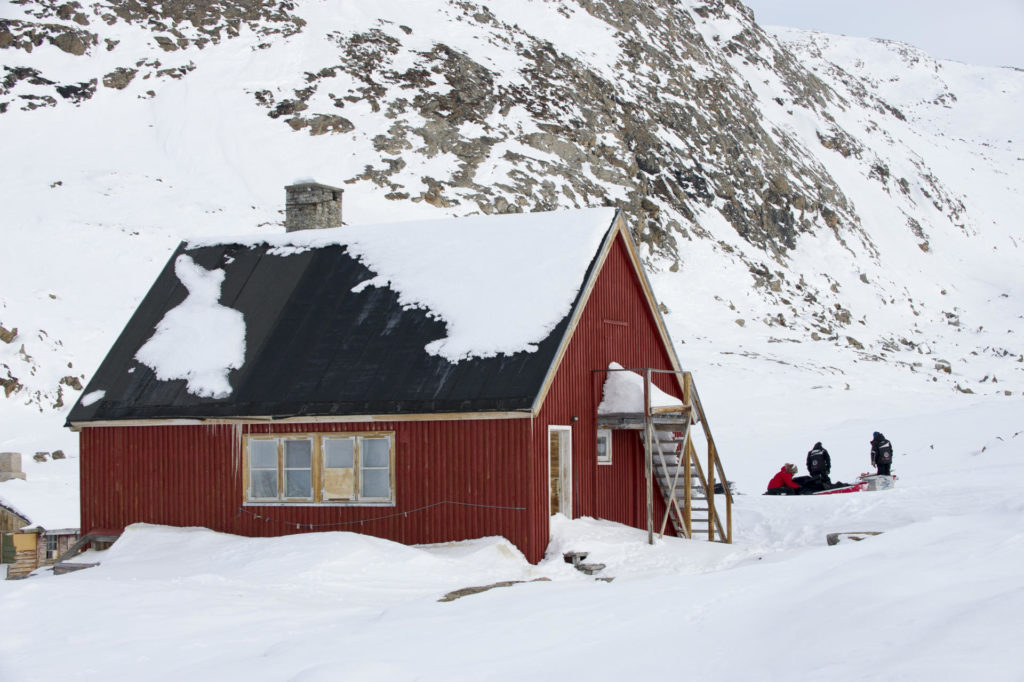
Getting Home
After refuelling, our little convoy limped back across the fjord toward the abandoned snowmobile. With visibility at about five meters, we navigated purely by GPS waypoints and, with a small amount of luck, came across the broken snowmobile without encountering any polar bears.
We quickly reorganized. One snowmobile would tow the disabled sled and the other two would have to pull two trailers each. With deep snow and the weight behind each snowmobile, stopping was not an option. If we stopped, we were bogged. If we were bogged, the chances of surviving out there were slim.
For four hours the two snowmobiles did their best to create a path for the trailing sled. There was no visibility, just endless white ahead and temperatures hovering around -20C. When we finally stopped on solid ground, no one moved. We were frozen in position, exhausted and only a quarter of the way home.
Reviving ourselves with a hot cup of tea, we checked on everyone’s condition and prepared for another 10 hours in the saddle.
Two-hundred kilometers to the east of our location, clinging to the frozen coastline, is a tiny village called Ittoqqortoormiit. The settlement is home to 450 people. North of Ittoqqortoormiit, there are no known permanent settlements. To the south, some 800 kilometers of glaciated mountainous terrain separate Ittoqqortoormiit from its closest neighbouring village.
Our base was our closest refuge, and the four shipping containers seemed like an oasis in this frozen desert. We pressed on.
After hours of sitting in the same position on a snow mobile, with your thumb locked on the throttle, you enter a trance-like state. The icebergs hold little interest as you drift by their frozen shapes, consumed by the single-minded purpose of getting back.
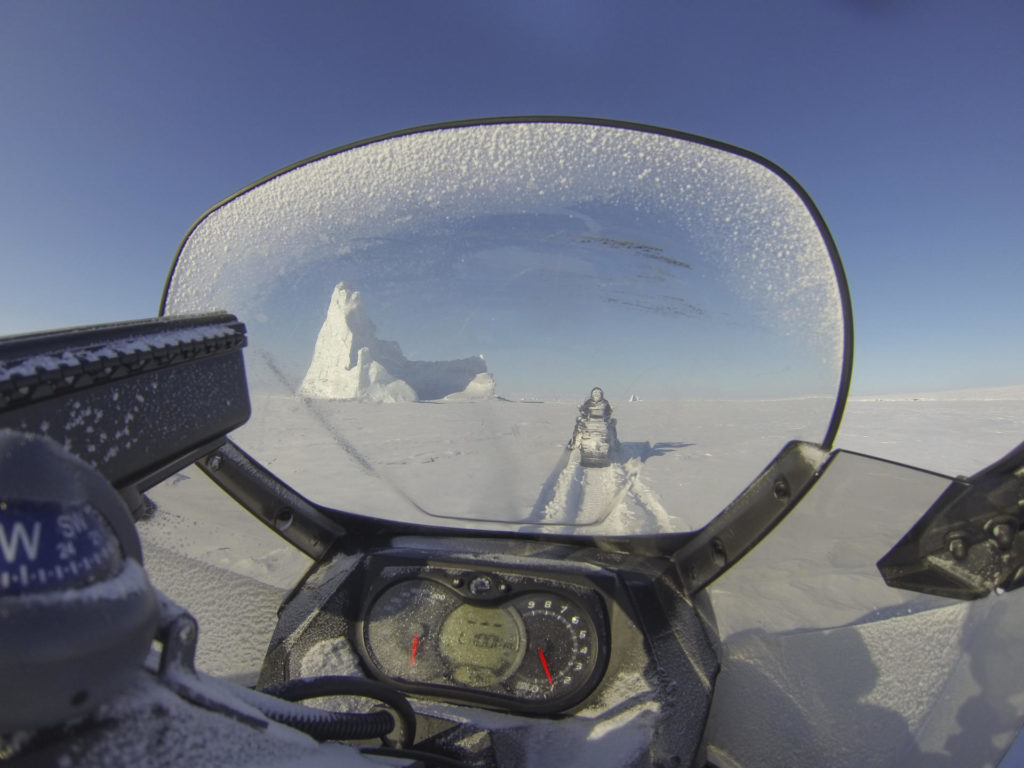
With so little to stimulate your mind, and so much time to think, you drift into strange states. With eyes wide open, I was essentially asleep at the wheel.
As the day blended into twilight, driving the sleds became more treacherous. We nodded off at the wheel, waking when helmets bumped the handlebars. Twice I accidentally hit the kill switch on my snowmobile with my visor. It’s not a pleasant feeling waking up at 50 km. per hour. as your snowmobile slows to a halt in deep snow while other sleep-deprived drivers are close behind.
It took all of our strength to fight off exhaustion, and I found myself losing the battle. Glances between us confirmed we shared the same fear; we wanted it to be over.
As twilight finally gave way to the few hours of darkness that descends this time of year, we caught our first glimpse of the lights of the camp far in the distance. We stopped and, after a moment of relief, we prepared for the home stretch, one of the worst sections of the journey.
The 30-kilometer stretch contained ferocious sastrugi – a wind blown, hard-packed, corrugated, ice, snow and dirt surface that comprises the unsuitably named Hurry Fjord.
An unrelenting wind howls down a cleft in the mountains to the north of the fjord and scours the surface of the ice with a brutality hard to measure. It is like trying to ride a jackhammer across a surface kicking back at you.
I vividly recall nature exerting her power on us here. No matter how slow or carefully we navigated the random spines of ice, we got slammed, tossed and thrown in every direction as the loads were shaken loose in the trailers. It was hell.
We limped slowly into camp some time between midnight and 2 a.m. We had made it.
When our base camp manager and Dean Miller, my filming partner, met us, it was elation verging on tears. “Deano” is a fellow Australian and a good mate. He had been the driving force of this Greenland trip. He is an unfatigable cameraman known for demanding above all else, “Did you get the shot!?”
He has lived and worked in Antarctica, Russia and points all over the world and is famed for standing down a polar bear charge with his video camera running, just to capture the footage. It’s always footage first, safety second with Deano.
He gave me a hug and didn’t say a word. The silence spoke of worry and immense relief. There were no questions about filming or the state of the $50,000 worth of equipment I’d just dragged for what felt like days behind my snowmobile.

In fact, we had spent 41 hours on snowmobiles and covered more than 400 kilometers of terrain. We’d endured deep powder, sastrugi and unimaginable temperatures and had traversed the length of the largest fjord in the world – twice.
During the brutal last push, I had lost sensation in my nose, fingers and toes. After I crawled into my sleeping bag, a burning pain spread to my extremities as blood reached them again. Yet I lay there and enjoyed the pain, a welcome reminder I was no longer on the snowmobile.
I know now that to live in the Arctic means suffering and to physically and mentally face incredibly harsh conditions. Mistakes here have severe consequences, and there are daily reminders of how insignificant you are amidst this frozen landscape. Yet, the suffering only heightens the reward – a natural beauty beyond description.




